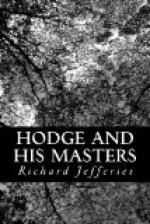When the village is reached at last, it is found to be of considerable size. The population is much greater than might have been anticipated from the desert-like solitude surrounding the place. In actual numbers, of course, it will not bear comparison with manufacturing districts, but for its situation, it is quite a little town. Compared with the villages situate in the midst of great pastures—where grass is the all-important crop—it is really populous. Almost all the inhabitants find employment in the fields around, helping to produce wheat and barley, oats and roots. It is a little city of the staff of life—a metropolis of the plough.
Every single house, from that of the landowner, through the rent; that of the clergyman, through the tithe—down to the humblest cottage, is directly interested in the crop of corn. The very children playing about the gaps in the hedges are interested in it, for can they not go gleaning? If the heralds had given the place a coat of arms it should bear a sheaf of wheat. And the reason of its comparative populousness is to be found in the wheat also. For the stubborn earth will not yield its riches without severe and sustained labour. Instead of tickling it with a hoe, and watching the golden harvest leap forth, scarifier and plough, harrow and drill in almost ceaseless succession, compel the clods by sheer force of iron to deliver up their treasure. In another form it is almost like the quartz-crushing at the gold mines—the ore ground out from the solid rock. And here, in addition, the ore has to be put into the rock first in the shape of manure.
All this labour requires hands to do it, and so—the supply for some time, at all events, answering the demand—the village teemed with men. In the autumn comes the ploughing, the couch-picking and burning, often second ploughing, the sowing by drill or hand, the threshing, &c. In the spring will come more ploughing, sowing, harrowing, hoeing. Modern agriculture has increased the labour done in the fields. Crops are arranged to succeed crops, and each of these necessitates labour, and labour a second and a third time. The work on arable land is never finished. A slackness there is in the dead of winter; but even then there is still something doing—some draining, some trimming of hedges, carting manure for open field work. But beyond this there are the sheep in the pens to be attended to as the important time of lambing approaches, and there are the horned cattle in the stalls still fattening, and leaving, as they reach maturity, for the butcher.




